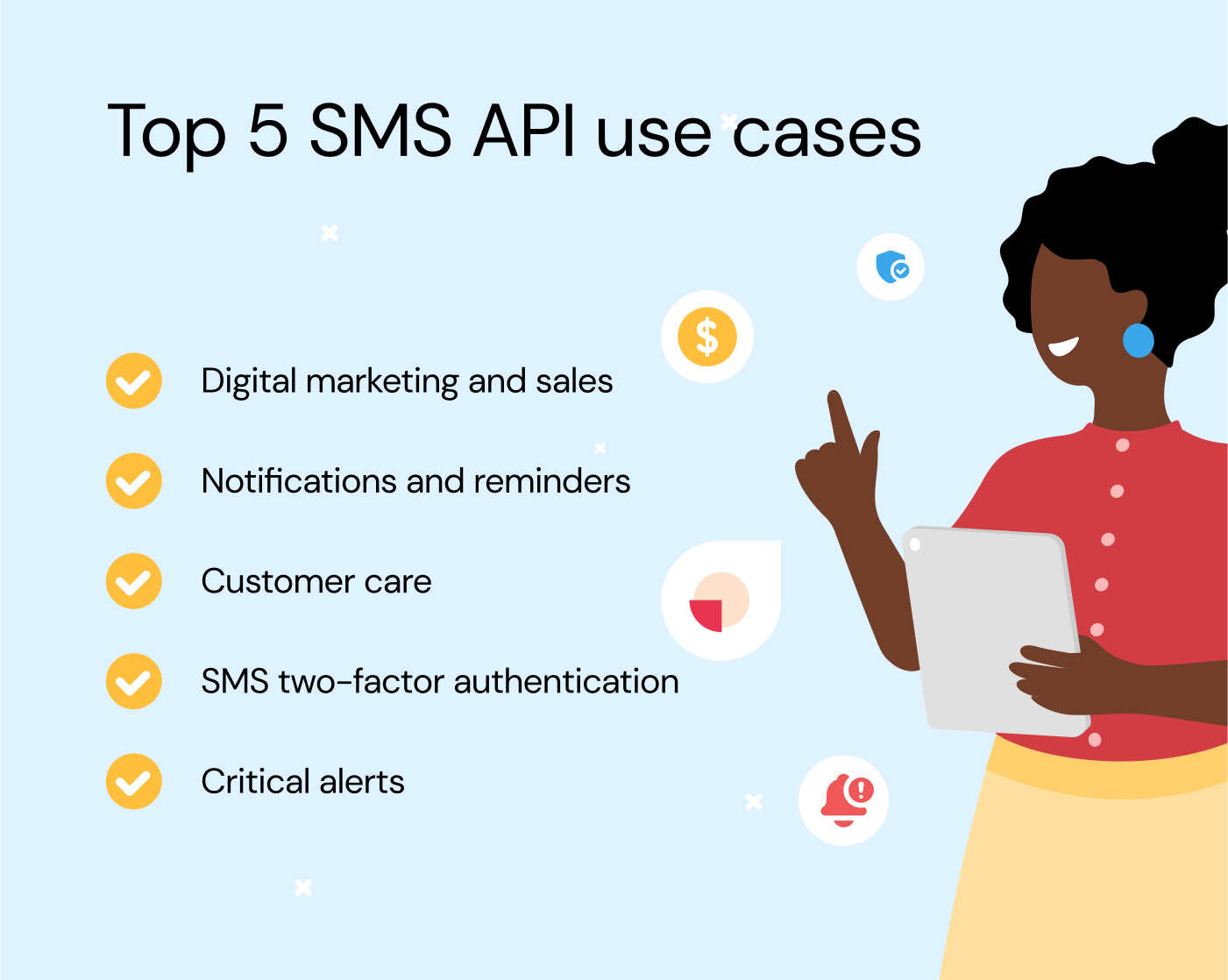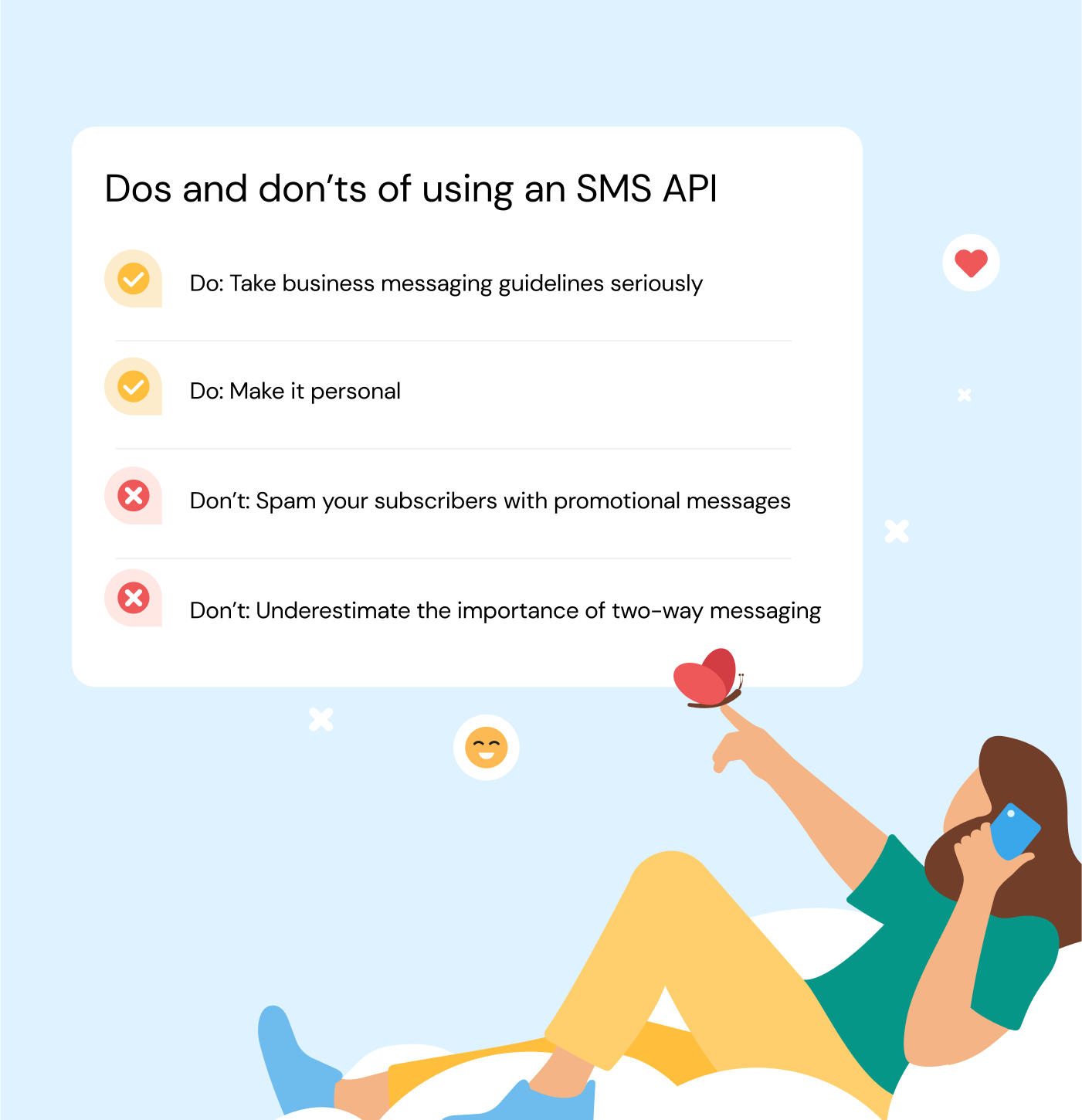In this article:
- What is an SMS API?
- How does SMS API integration work?
- Why you need an SMS API
- SMS API use cases
- Understand the basics of SMS API technology
- Dos and don’ts of using an SMS API to message customers
- So, what is an SMS API? The backbone of engaging, reliable communications
- SMS API: Frequently asked questions
Millions of customers receive SMS messages from brands daily, but how exactly can businesses scale these communications to instantly reach large audiences at any given moment, anywhere in the world?
For most businesses, the answer is: by using an SMS API!
Despite the abundance of messaging channels available today, SMS is still the most common messaging type worldwide and the technology helping businesses get the most out of this ever-so-popular channel has come a long way since its invention in 1992.
With SMS APIs, businesses can send, receive, and track text messages at scale directly from their existing applications — quickly, easily, and automatically. No need to manage complex in-house infrastructure or involve an entire IT team!
In this blog post, we’re answering all the questions you might have about SMS APIs: what they are, how they work, their benefits, how businesses use them, and how to pick the right SMS API service for your company.
What is an SMS API?
An Application Programmable Interface (API) is a software intermediary enabling communication between two or more applications or systems. Businesses can use APIs to easily expand the capabilities of their existing tools.
An SMS API, as the name suggests, is a type of API that allows businesses to add SMS messaging capabilities to their applications and platforms.
How does SMS API integration work?
To start sending text messages, you’ll need to integrate the SMS API into your application or platform. Your provider will then route your messages to mobile networks using an SMS gateway.
A good SMS API provider will make integration easier for your company’s developers by providing in-depth documentation for multiple programming languages like Java, PHP, Node, .NET Core, or Python. A great one will also help you set it up and support you every step of the way!
With Sinch’s SMS API, for instance, a few simple steps is all it takes to get up and running and start sending messages:
1. Sign up for a free account on the Sinch Customer Dashboard.
2. Get a free virtual number for testing; you’ll use it to send test messages.
3. Get credentials.
4. Select a language and follow our instructions to set up a simple application.
Once the API is integrated, you’ll be ready to start sending large volumes of SMS messages automatically. You can try our SMS API for free here.
Why you need an SMS API
More than thirty years after its invention, SMS is still one of the most popular communication channels, and it’s no coincidence. Here's how an SMS API can transform business communications:
Instant attention and unbeatable engagement at scale
An SMS API allows businesses to get instant customer attention and increase engagement through a medium that’s always at hand — and to do so at scale.
With a whopping 98% open rate and 90% read rate within three minutes, SMS APIs ensure that offers, invites, reminders, and notifications are delivered reliably and securely — and acted on.
Easy SMS API integration
An SMS API takes the headache out of the picture and allows developers to build messaging capabilities into their existing software quickly and easily. With the right partner, you’ll start sending your first text messages within minutes.
Industry-leading SMS API providers also offer connectors and out-of-the-box integrations to many of the most popular CRM and ERP systems.
Automated SMS sendouts
For businesses in need of more than just a manual SMS system, an SMS API is the perfect way to send thousands of SMS messages automatically. Not only does it help you work smarter, but it also ensures time-sensitive communications reach customers at the right time, every single time — no matter how big your customer database.
Deeper customer insights
Because they typically provide better tracking and analytics capabilities (like campaign management or delivery monitoring), SMS APIs can also help you make more informed decisions about your communication strategy and identify potential issues faster.
Two-way messaging capabilities
Another major advantage of an SMS API is that it usually supports both one-way and two-way messaging. Why does it matter? Because your customers really want to text you back! Recent Sinch research found that 90% (ninety!) of customers would love to be able to answer messages from brands to ask questions.
While one-way SMS is still great for some use cases, two-way messaging takes it to the next level and helps businesses build deeper connections through conversations.
Reliable message delivery
When chosen right, an SMS API ensures fast, secure, and reliable message delivery, wherever your recipients are.
No maintenance
With an SMS API, no need to worry about upgrades and maintenance. Your provider will take care of it for you, without any disruption to your workflows, saving you both time and money.
Global compliance and security
When it comes to business communications, compliance and security aren’t things you can compromise on. Your SMS API provider can (or rather, should) help you navigate complex regulatory requirements like data protection and privacy laws and ensure your business communications are secure.
Cost-effective pricing
Bulk SMS messaging is a cost-effective way to reach thousands of customers instantly — and think about the ROI you can get from such an incredibly engaging channel! Some SMS providers also offer smart routing, which means you can choose to prioritize cost or speed depending on your needs.
Now let’s look at how businesses across different industries use SMS APIs to drive positive business outcomes.
SMS API use cases
From alerts to SMS one-time passcodes (OTPs), appointment reminders, customer support, or promotions, an SMS API ensures you're relevant and timely.

Digital marketing and sales
Keep customers in the know about your upcoming sales and latest product releases, remind them of the items left in their cart, or send them personalized recommendations based on their purchase history. An SMS API will help you take your SMS marketing strategy to the next level and send conversion and engagement rates through the roof.
Notifications and reminders
Elevate every step of the customer journey with helpful information. Whether you’re sending an order confirmation, a delivery update, or an appointment reminder to reduce no-shows, an SMS API helps you get your message across at the right time, every single time.
When Budbee, a home delivery company, set out to take customer experience to a whole new level, they made SMS central to their strategy. The company teamed up with Sinch to send delivery tracking text messages to customers with personalization options.
The results speak for themselves: 50% less time spent on maintenance, reduced communications costs — and happy customers.
Customer care
Support customers on a channel they already use daily — they’ll thank you for it! Two-way SMS is a fast and convenient way to provide helpful answers to customer queries — and with conversational AI, you can do so 24/7 and free up time for your support teams.
SMS two-factor authentication
Secure your customer journey while increasing conversions and reducing churn. An SMS API enables fast, user-friendly messaging at scale.
Take Triodos, for instance, a world leader in sustainable banking. To add an extra layer of account security while simplifying sign-ups and logins, the company rolled out SMS verification from Sinch.
Triodos now sends approximately 250,000 text messages per month to verify users logging in to their mobile app or online portal. Not only did it help prevent fraudulent transactions and enhance user experience, but this simplified sign-up process also helped them win new customers.
Critical alerts
When the unexpected happens, fast and reliable communications can save the day. Whether it’s a fraud suspicion on a customer’s bank account, a natural disaster, or a service outage, an SMS API ensures critical messages get delivered quickly and reliably. And here again, two-way messaging can prove very useful to allow recipients to ask questions or provide any necessary information.
Thanks to two-way SMS, Nets handles their transaction validation process directly with the cardholder in case of suspicious account activity, ensuring speed and a better user experience for the cardholder.
As you can tell, an SMS API can benefit businesses across all industries in many ways — so long as you use it right.
Understand the basics of SMS API technology
Because SMS is such an integral part of our everyday lives, it’s easy to forget how complex it actually is — but we’ve got you covered! Here’s a quick guide to fundamental SMS concepts you need to understand.
-
Sender ID
A Sender ID is a numeric or alphanumeric value that identifies the sender of an SMS message. In other words, the sender ID is what’s displayed in the SMS “From” field.
Some sender IDs allow businesses to personalize their SMS branding, for instance by using a company or campaign name as the sender ID (but keep in mind that this is possible only for one-way messages).
-
Latency
SMS latency refers to the speed of delivery of a message; it’s the amount of time it takes for a message sent via an SMS API to be delivered to its recipient.
Latency may vary from one provider to another, so if you’re sending time-sensitive messages like verification codes or other critical alerts, check this carefully when selecting your SMS API.
A reliable provider will have a robust network infrastructure with connections to all major telecom carriers worldwide — this is what ensures messages get delivered quickly and reliably.
At Sinch, we've got over 600 direct carrier connections worldwide and proactively monitor our delivery times so you can reach your audience anywhere in the world in seconds or less.
-
Messaging throughput
Throughput refers to how many messages can be sent per second and is usually expressed in TPS (Throughput Per Second). Throughput rates vary depending on the type of sender ID you use (e.g. short code, long code, toll-free number, etc.).
Why does it matter? Because throughput is what ensures your messages are being delivered when they should be!
-
Delivery status
When sending SMS messages, most mobile operators will send delivery receipts to the SMS API provider to inform them about the delivery status of the message — and we pass this information on to you to help you keep track of your messages.
With Sinch’s SMS delivery receipt feature (DLR), you can easily monitor the delivery of your messages and troubleshoot potential issues.
-
Message encoding and character limits
An SMS can contain up to 160 characters — you might already know this. But that’s in theory. In reality, it’s a bit more complex than that.
When creating an SMS message, the characters used and the length of the message determine the type of encoding and the number of messages being sent out.
You can send up to 160 characters in a single SMS message if all characters are part of the GSM 7-bit character set.
Some other characters might be counted as two characters in the message or require a different type of encoding, for instance 16-bit Unicode (UCS-2) encoding.
For messages exceeding 160 characters, multiple messages will be sent; in most cases, they’ll automatically be displayed as a single message on the recipient’s handset.
You can read more about message encoding and character limits here.
Now that we’ve got the basics covered, it’s time to put that technology to work at your company! But before you start using a text message API, make sure you’re aware of general messaging best practices.
Dos and don’ts of using an SMS API to message customers
There’s a right and wrong way to go about using a text message API. Here are some of the key best practices you should keep in mind.

Do: Take business messaging guidelines seriously
Let’s face it: Keeping up with local laws and regulations around SMS messaging is complicated, because different rules apply depending on the market you're sending SMS to and the type of phone number you’re using.
But if there's only one thing you should remember about SMS guidelines, it's this: Never (ever) send messages to people who haven’t opted in! That’s the golden rule of business messaging — and you don’t want to mess with it. It's also important to give subscribers an easy way to opt out.
If you ask us, the best way to stay out of trouble and avoid hefty fines or carrier filtering is to choose an SMS API provider who’ll help you stay on top of compliance.
Do: Leverage your API’s personalization features
SMS is a highly personal channel; customers use it to interact with friends and family. So, act like a friend and show that you care with personalized content. This also applies to the timing of your messages. Who likes being woken up in the middle of the night by a random text message from a brand? That’s right: No one. So, keep this in mind when setting up your SMS communication flows.
Don’t: Underestimate the importance of two-way messaging capabilities
As previously mentioned, research clearly shows that it’s time for businesses to turn one-way, static SMS notifications into conversations — because your customers have questions!
Need more proof? A global study by Meta found that almost two-thirds of consumers tried to respond to direct messages sent by brands during the holiday season, for instance to get product or pricing information, or personalized advice.
The problem? Most companies aren’t set up for two-way messaging.
So, if you care about customer experience and satisfaction (and we know you do!), look into SMS APIs that offer two-way messaging capabilities — not every platform does.
Don’t: Spam your subscribers with promotional messages
While bulk messaging is great for reaching and engaging a large number of recipients at once, remember that your customers are already flooded with messages from brands across all the channels they use. So, if you want to keep your SMS subscribers opted-in, don’t overdo it and go easy on sales-focused content. Instead, prioritize value-adding, helpful messages.
So, what is an SMS API? The backbone of engaging, reliable communications
If you want to reach customers instantly and reliably on a channel they already use, an SMS API is the way to go — but not all SMS API services are created equal.
We break down everything you need to consider when selecting an SMS API provider in our recent blog post. Check it out and choose with confidence! You can also download our handy cheat sheet below.

SMS API: Frequently asked questions
How much does an SMS API cost?
The cost of an SMS API will depend on the provider you choose, the volume of SMS messages you need to send, and the type of number you use.
Pro tip: Be extra cautious about SMS API services offering below-market prices. When it seems too good to be true, it usually is...
What is an SMS API used for?
An SMS API is used by businesses across all industries to send large volumes of SMS messages to customers automatically, including notifications, reminders, verification codes, promotional messages, and more.
How can I get started with an SMS API?
Here at Sinch, we’re all about keeping it simple. Our technical support team will help you set it up and get up and running in no time!
How to choose the right SMS API service for your company?
Ask any potential provider about its connectivity infrastructure, customer support and SLAs, security and compliance certifications, and integration process. And make sure to check out what existing customers and industry experts say about the provider, too.
How do I scale and maintain my text message API?
The right SMS API provider will take care of upgrades and maintenance for you. The right partner should also be able to address your present and future messaging needs and scale with you as you expand to new markets and grow your customer database.



